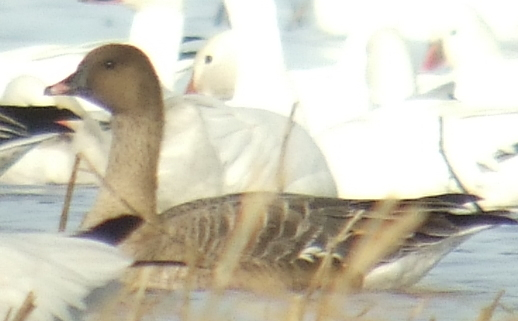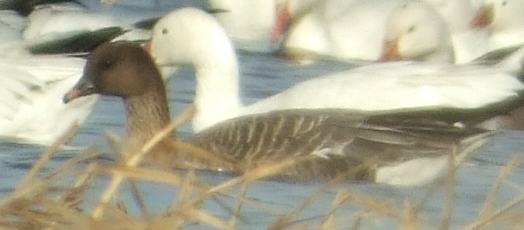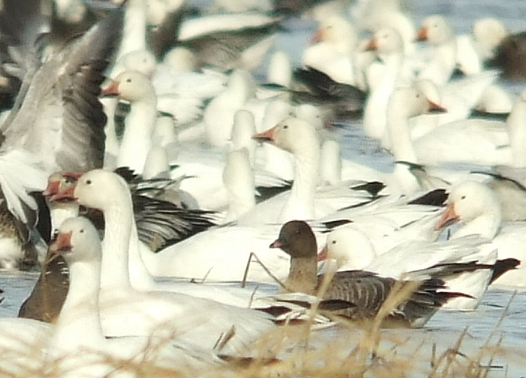Anser brachyrhynchus
Status: Accidental in winter.
Documentation: Photograph: 30 Jan 2006 Harvard WPA, Clay Co (Brogie 2007, 2025).
Taxonomy: No subspecies are recognized (AviList 2025).
Sometimes treated as a subspecies of Taiga Bean-Goose (Anser fabalis) but is strongly differentiated genetically (AviList 2025).
Record: One was found and photographed by Paul Dunbar in a flock of 50,000-80,000 Snow Geese at Harvard WPA, Clay Co, 30 Jan 2006 (Brogie 2007; eBird Checklist – 30 Jan 2006 – Harvard WPA). Identification of the bird was not in question, but the NOURC in 2007 did not accept the report because of doubts regarding the bird’s provenance. Upon re-review, NOURC voted to accept the record based on neck collar information (see below) not available to the Committee earlier (Brogie 2025).
Comments: Although concerns regarding provenance are reasonable for out-of-range waterfowl and origin of such a vagrant will likely never be determined with certainty, increasing records since around 2000 in the eastern US provide additional support that this occurrence involved a wild bird.
Recovery data from neck collars on Snow Geese from the same flock in which the Nebraska Pink-footed Goose was found showed individual Snow Geese were captured at Queen Maud Gulf Migratory Bird Sanctuary in Nunavut, Canada (Paul Dunbar, personal communication). The date of the Nebraska sighting is consistent with the timing of numerous and increasing occurrences of wild Pink-footed Geese in the northeast United States in the last 25 years (Howell et al 2014). Breeders in Iceland and Greenland that winter in Great Britain have increased in numbers more than 10-fold during the past 60 years (Banks et al 2006, Howell et al 2014). The Nebraska bird may have been associated with Greater Snow Geese (Anser caerulescens atlanticus) in the northeast United States and migrated north with them. The breeding population of Greater Snow Goose, centered on Bylot Island, has “increased dramatically” from 180,000 in 1980 to 800,000-1,000,000 in 2007, and has expanded its breeding range, coming into closer proximity to populations of Lesser Snow Geese breeding as far east as Bylot Island (Baldassarre 2014). Pink-footed Geese are “rare” in captivity in North America (Howell et al 2014). There is one other record for the Great Plains, one in Weld Co, Colorado 11-12 Dec 2018 (eBird.org, accessed Feb 2025).
Images
Abbreviations
NOURC: Nebraska Ornithologists’ Union Records Committee
WPA: Waterfowl Production Area (Federal)
Literature Cited
AviList Core Team, 2025. AviList: The Global Avian Checklist, v2025. https://doi.org/10.2173/avilist.v2025.
Baldassarre, G. 2014. Ducks, Geese, and Swans of North America. Johns Hopkins University Press, Baltimore, Maryland, USA.
Banks, A., M. Collier, G. Austin, R. Hearn, and A. Musgrove. 2006. Waterbirds in the UK 2004/05. The Wetland Bird Survey. Thetford, UK.
Brogie, M.A. 2007. 2006 (18th) Report of the NOU Records Committee. NBR 75: 86-94.
Brogie, M.A. 2025. NBR, in press.
Howell, S.N.G., I. Lewington, and W. Russell. 2014. Rare birds of North America. Princeton and Oxford: Princeton University Press, New Jersey, USA.
Recommended Citation
Silcock, W.R., and J.G. Jorgensen. 2025. Pink-footed Goose (Anser brachyrhynchus). In Birds of Nebraska — Online. www.BirdsofNebraska.org
Birds of Nebraska – Online
Updated 3 Jul 2025



